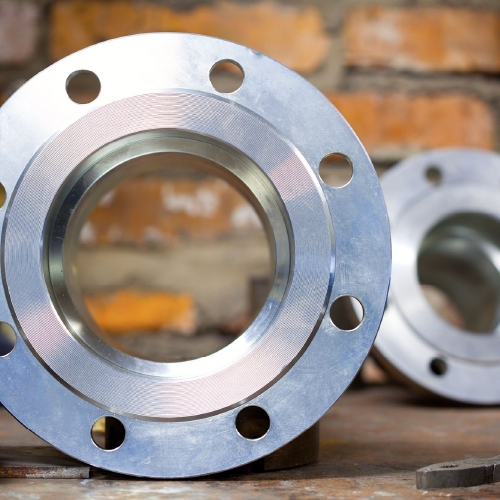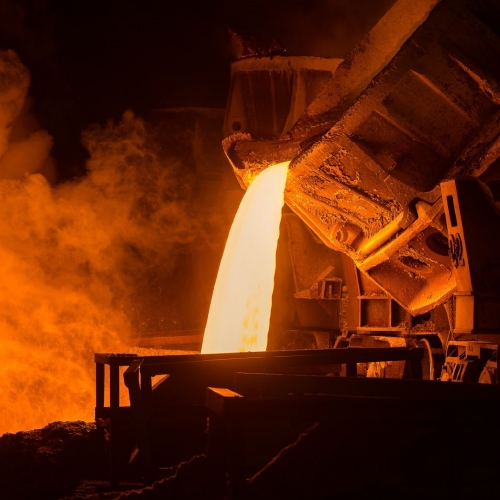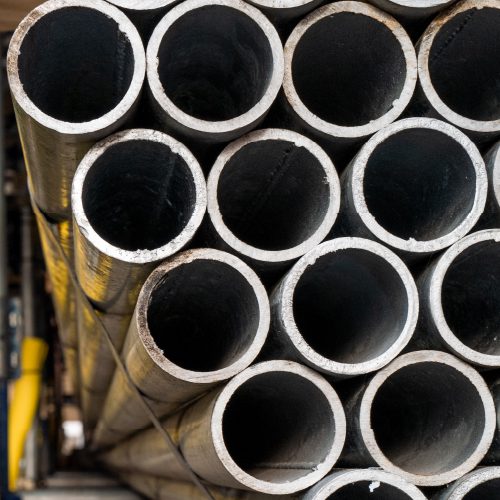Corrosion Resistance Of Metals To Aggressive Fluids

CORROSION RESISTANCE OF METALS TO AGGRESSIVE FLUIDS
Overview Of This Article
Introduction To Corrosion Resistance Of Metals To Aggressive Fluids
When most metals like Stainless Steel, Mild Steel, Aluminum, etc. come into contact with certain substances in the air or water, they undergo a chemical change that decreases the integrity of the metal. This process is called corrosion. Oxygen, sulfur, salt, and other materials can all lead to various types of corrosion. When a metal corrodes or deteriorates, it cannot hold the same loads or showcase the engineering properties as it did before corrosion began.
At a certain point, corrosion can lead to dangerous conditions and damage the system or equipment. The metals used in bridges, railroad tracks, and buildings are all subject to corrosion. Because of this, it is important to monitor and manage corrosion to avoid structural collapse and fatal damages.
Corrosion Resistance Of Metals To Aggressive Fluids
Corrosion is a complicated issue, depending on the combinations of materials and the fluids, the fluid temperatures, the surrounding environment and the galvanic currents in constructions. The table below must be used with care. Always check with the engineering team to ensure complete compatibility of the material and fluid for the desired environment and application.
Key Legend:
1 = Good
2 = Careful
3 = Bad
| Fluid | Metal | |||||||||||
|---|---|---|---|---|---|---|---|---|---|---|---|---|
| Carbon Steel | Cast Iron | Stainless Steel 304 | Stainless Steel 316 | Bronze | Durimet | Monel | Hastelloy B | Hastelloy C | Titanium | Cobalt Base Alloy 6 | Stainless Steel 416 | |
| Acetaldehyde | 1 | 1 | 1 | 1 | 1 | 1 | 1 | NA | 1 | NA | NA | 1 |
| Acetic Acid, Air Free | 3 | 3 | 2 | 2 | 2 | 1 | 2 | 1 | 1 | 1 | 1 | 3 |
| Acetic Acid, Aerated | 3 | 3 | 1 | 1 | 1 | 1 | 1 | 1 | 1 | 1 | 1 | 3 |
| Acetic Acid, Vapors | 3 | 3 | 1 | 1 | 2 | 2 | 2 | NA | 1 | 1 | 1 | 3 |
| Acetone | 1 | 1 | 1 | 1 | 1 | 1 | 1 | 1 | 1 | 1 | 1 | 1 |
| Acetylene | 1 | 1 | 1 | 1 | NA | 1 | 1 | 1 | 1 | NA | 1 | 1 |
| Alcohols | 1 | 1 | 1 | 1 | 1 | 1 | 1 | 1 | 1 | 1 | 1 | 1 |
| Aluminum Sulfate | 3 | 3 | 1 | 1 | 2 | 1 | 2 | 1 | 1 | 1 | NA | 3 |
| Ammonia | 1 | 1 | 1 | 1 | 3 | 1 | 3 | 1 | 1 | 1 | 1 | 1 |
| Ammonium Chloride | 3 | 3 | 2 | 2 | 2 | 1 | 2 | 1 | 1 | 1 | 2 | 3 |
| Ammonium Nitrate | 1 | 3 | 1 | 1 | 3 | 1 | 3 | 1 | 1 | 1 | 1 | 3 |
| Ammonium Phosphate | 3 | 3 | 1 | 1 | 2 | 2 | 2 | 1 | 1 | 1 | 1 | 2 |
| Ammonium Sulfate | 3 | 3 | 2 | 1 | 2 | 1 | 1 | 1 | 1 | 1 | 1 | 3 |
| Ammonium Sulfite | 3 | 3 | 1 | 1 | 3 | 1 | 3 | NA | 1 | 1 | 1 | 2 |
| Aniline | 3 | 3 | 1 | 1 | 3 | 1 | 2 | 1 | 1 | 1 | 1 | 3 |
| Asphalt | 1 | 1 | 1 | 1 | 1 | 1 | 1 | 1 | 1 | NA | 1 | 1 |
| Beer | 2 | 2 | 1 | 1 | 2 | 1 | 1 | 1 | 1 | 1 | 1 | 2 |
| Benzene (Benzol) | 1 | 1 | 1 | 1 | 1 | 1 | 1 | 1 | 1 | 1 | 1 | 1 |
| Benzoic Acid | 3 | 3 | 1 | 1 | 1 | 1 | 1 | NA | 1 | 1 | NA | 1 |
| Boric Acid | 3 | 3 | 1 | 1 | 1 | 1 | 1 | 1 | 1 | 1 | 1 | 2 |
| Butane | 1 | 1 | 1 | 1 | 1 | 1 | 1 | 1 | 1 | NA | 1 | 1 |
| Calcium Chloride (Alkaline) | 2 | 2 | 3 | 2 | 3 | 1 | 1 | 1 | 1 | 1 | NA | 3 |
| Calcium Hypochlorite | 3 | 3 | 2 | 2 | 2 | 1 | 2 | 3 | 1 | 1 | NA | 3 |
| Carbolic Acid | 2 | 2 | 1 | 1 | 1 | 1 | 1 | 1 | 1 | 1 | 1 | NA |
| Carbon Dioxide, Dry | 1 | 1 | 1 | 1 | 1 | 1 | 1 | 1 | 1 | 1 | 1 | 1 |
| Carbon Dioxide, Wet | 3 | 3 | 1 | 1 | 2 | 1 | 1 | 1 | 1 | 1 | 1 | 1 |
| Carbon Disulfide | 1 | 1 | 1 | 1 | 3 | 1 | 2 | 1 | 1 | 1 | 1 | 2 |
| Carbon Tetrachloride | 2 | 2 | 2 | 2 | 1 | 1 | 1 | 2 | 1 | 1 | NA | 3 |
| Carbonic Acid | 3 | 3 | 2 | 2 | 2 | 1 | 1 | 1 | 1 | NA | NA | 1 |
| Chlorine Gas | 1 | 1 | 2 | 2 | 2 | 1 | 1 | 1 | 1 | 1 | 2 | 3 |
| Chlorine Gas, Wet | 3 | 3 | 3 | 3 | 3 | 3 | 3 | 3 | 2 | 1 | 2 | 3 |
| Chlorine, Liquid | 3 | 3 | 3 | 3 | 2 | 2 | 3 | 3 | 1 | 1 | 2 | 3 |
| Chromic Acid | 3 | 3 | 3 | 2 | 3 | 3 | 1 | 3 | 1 | 1 | 2 | 3 |
| Citric Acid | 3 | 3 | 2 | 1 | 1 | 1 | 2 | 1 | 1 | 1 | NA | 2 |
| Coke Oven Gas | 1 | 1 | 1 | 1 | 2 | 1 | 2 | 1 | 1 | 1 | 1 | 1 |
| Copper Sulfate | 3 | 3 | 2 | 2 | 2 | 1 | 3 | NA | 1 | 1 | NA | 1 |
| Cottonseed Oil | 1 | 1 | 1 | 1 | 1 | 1 | 1 | 1 | 1 | 1 | 1 | 1 |
| Cresote | 1 | 1 | 1 | 1 | 3 | 1 | 1 | 1 | 1 | NA | 1 | 1 |
| Ethane | 1 | 1 | 1 | 1 | 1 | 1 | 1 | 1 | 1 | 1 | 1 | 1 |
| Ether | 2 | 2 | 1 | 1 | 1 | 1 | 1 | 1 | 1 | 1 | 1 | 1 |
| Ethyl Chloride | 3 | 3 | 1 | 1 | 1 | 1 | 1 | 1 | 1 | 1 | 1 | 2 |
| Ethylene | 1 | 1 | 1 | 1 | 1 | 1 | 1 | 1 | 1 | 1 | 1 | 1 |
| Ethylene Glycol | 1 | 1 | 1 | 1 | 1 | 1 | 1 | NA | NA | NA | 1 | 1 |
| Ferric Chloride | 3 | 3 | 3 | 3 | 3 | 3 | 3 | 3 | 2 | 1 | 2 | 3 |
| Formaldehyde | 2 | 2 | 1 | 1 | 1 | 1 | 1 | 1 | 1 | 1 | 1 | 1 |
| Formic Acid | 3 | 3 | 2 | 2 | 1 | 1 | 1 | 1 | 1 | 3 | 2 | 3 |
| R-12 Dichlorodifluoromethane Wet | 2 | 2 | 2 | 1 | 1 | 1 | 1 | 1 | 1 | 1 | 1 | NA |
| R-12 Dichlorodifluoromethane Dry | 2 | 2 | 1 | 1 | 1 | 1 | 1 | 1 | 1 | 1 | 1 | NA |
| Furfural | 1 | 1 | 1 | 1 | 1 | 1 | 1 | 1 | 1 | 1 | 1 | 2 |
| Gasoline | 1 | 1 | 1 | 1 | 1 | 1 | 1 | 1 | 1 | 1 | 1 | 1 |
| Glucose | 1 | 1 | 1 | 1 | 1 | 1 | 1 | 1 | 1 | 1 | 1 | 1 |
| Hydrochloric Acid, Aerated | 3 | 3 | 3 | 3 | 3 | 3 | 3 | 1 | 2 | 2 | 2 | 3 |
| Hydrochloric Acid, Air Free | 3 | 3 | 3 | 3 | 3 | 3 | 3 | 1 | 2 | 2 | 2 | 3 |
| Hydrofluoric Acid, Aerated | 2 | 3 | 3 | 2 | 3 | 2 | 3 | 1 | 1 | 3 | 2 | 3 |
| Hydrofluoric Acid, Air Free | 1 | 3 | 3 | 2 | 3 | 2 | 1 | 1 | 1 | 3 | NA | 3 |
| Hydrogen | 1 | 1 | 1 | 1 | 1 | 1 | 1 | 1 | 1 | 1 | 1 | 1 |
| Hydrogen Peroxide | NA | 2 | 1 | 1 | 3 | 1 | 3 | 2 | 2 | 1 | NA | 2 |
| Hydrogen Sulfide, Liquid | 3 | 3 | 1 | 1 | 3 | 2 | 3 | 1 | 1 | 1 | 1 | 3 |
| Magnesium Hydroxide | 1 | 1 | 1 | 1 | 2 | 1 | 1 | 1 | 1 | 1 | 1 | 1 |
| Mercury | 1 | 1 | 1 | 1 | 3 | 1 | 2 | 1 | 1 | 1 | 1 | 1 |
| Methanol | 1 | 1 | 1 | 1 | 1 | 1 | 1 | 1 | 1 | 1 | 1 | 1 |
| Methyl Ethyl Ketone | 1 | 1 | 1 | 1 | 1 | 1 | 1 | 1 | 1 | NA | 1 | 1 |
| Milk | 3 | 3 | 1 | 1 | 1 | 1 | 1 | 1 | 1 | 1 | 1 | 3 |
| Natural Gas | 1 | 1 | 1 | 1 | 1 | 1 | 1 | 1 | 1 | 1 | 1 | 1 |
| Nitric Acid | 3 | 3 | 1 | 2 | 3 | 1 | 3 | 3 | 2 | 1 | 3 | 3 |
| Oleic Acid | 3 | 3 | 1 | 1 | 2 | 1 | 1 | 1 | 1 | 1 | 1 | 1 |
| Oxalic Acid | 3 | 3 | 2 | 2 | 2 | 1 | 2 | 1 | 1 | 2 | 2 | 2 |
| Oxygen | 1 | 1 | 1 | 1 | 1 | 1 | 1 | 1 | 1 | 1 | 1 | 1 |
| Petroleum Oils | 1 | 1 | 1 | 1 | 1 | 1 | 1 | 1 | 1 | 1 | 1 | 1 |
The above mentioned details are for reference purpose only.
*NA = Data Not Available
Corrosion Resistance Of Metals To Aggressive Fluids: The Conclusion
Corrosion resistance of metals to aggressive fluids is a topic that deals with the ability of metals to resist degradation when exposed to harsh environments such as acidic or alkaline solutions, seawater, or high-temperature gases. The corrosion of metals can result in structural damage, reduced performance, and ultimately failure of the material. Therefore, understanding the corrosion resistance of different metals is critical in selecting appropriate materials for various applications. The table above is for reference purpose only, the real-life performance of the metal is affected by the environment of the application.
THANK YOU
DON'T MISS ON LATEST ARTICLES!
SIGN UP NOW!







